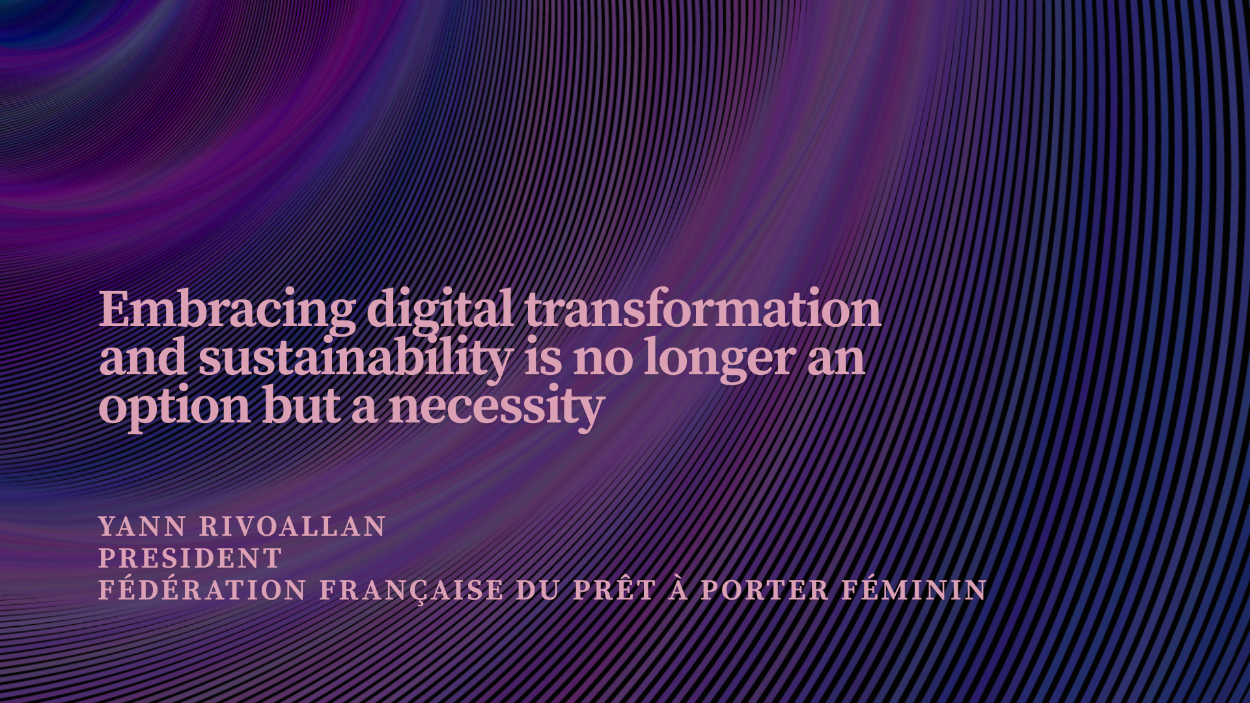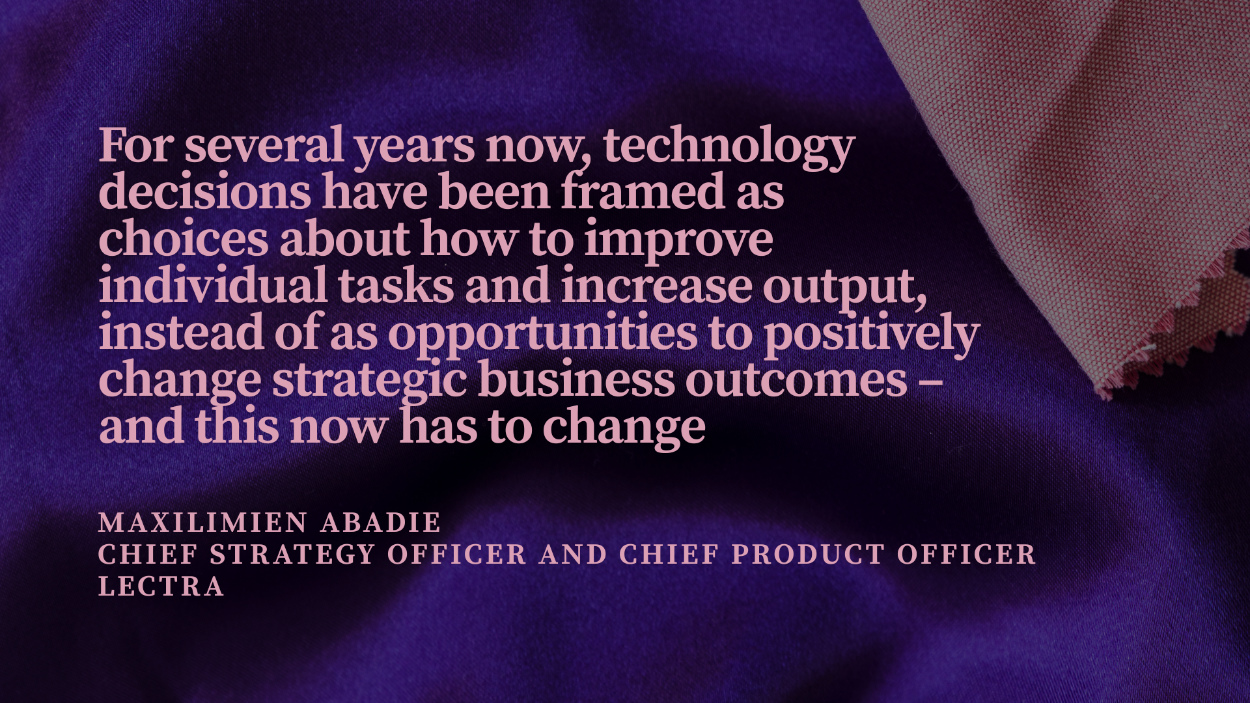To accompany the release of a new 15-page report from Lectra, documenting a unique period of deep challenges and historic opportunities for fashion, The Interline considers some of the key conclusions and the important actions – across the extended product lifecycle – that leading brands will need to take today in order to secure their futures.
Featuring exclusive perspectives from senior figures at luxury jewellery brand Boucheron, London’s renowned Fashion Innovation Agency, the American Apparel & Footwear Association (AAFA), storied full-service supply chain partner MAS Holdings, the Fédération Française du Prêt à Porter Féminin, sustainable business publication The Good Goods, Lectra itself, and The Interline, the full report is available to download today.
Fashion is not new to the catalysts for, or the practical realities of managing, change. From accessible style to the highest tiers of luxury, plenty of today’s iconic brands and household names were forged or refined in pivotal moments – times where the world around the industry was rocked by external forces, or reshaped by a technological leap forward.
The brands we cherish did not earn their position in our collective memories just because they had the best stories to tell, or the best products to sell. Many of them thrived – and outlasted their competition – because they identified the opportunity to innovate, to pioneer, or to advance a particular part of their business as a way of getting ahead of a threat or of grasping a new possibility.
But even though that same attitude to the necessity of innovation is still widespread today, fashion is now being asked to meet a fundamentally different moment – one unlike anything else the industry has faced before.

Speaking as part of the brand-new strategic report from Lectra, Yann Rivoallan, President of Fédération Française du Prêt à Porter Féminin, calls the current reality “[…] a decisive turning point where embracing digital transformation and sustainability is no longer an option but a necessity”.
This necessity is being created by a unique combination of external forces (those unpredictable variables that are shifting the playing fields of fashion markets season-by-season, and disrupting the world economy day-by-day) and intrinsic attributes of the fashion industry itself – some of which are fixed in place, but others that are overdue to be challenged.
In the immediate term, fashion brands and retailers are being buffeted by quick-changing but extremely disruptive headwinds, as the lines that have traditionally shaped and defined global trade are being redrawn by unpredictable policy shifts. These external forces are liable to change at extremely short notice, but their impacts are much longer lasting: just this week the United States and China reached a deal to reduce import tariffs from 125% (a rate they had previously stabilised at following a pitched trade dispute) to 10%, but as a result of that deadlock, shipping volumes between the two nations have dwindled to levels not seen since the COVID pandemic, and they may not recover in time to avoid stock-outs that will be felt on retailers’ bottom lines.
At the same time, those same organisations are also facing market competition of an entirely new shape and scale, with digital-native overseas companies stepping into markets that incumbents had thought were secure.
After setting new benchmarks for price and variety, these new disruptors demanded that long-established companies not only create, make, and market better, but that they fundamentally overhaul their core models to recapture existing demographics at a time when key markets are also seeing declining birth rates that will further undermine growth.
And the resources that these companies have at their disposal to tackle these multi-pronged priorities are perhaps more scarce and more brittle than ever.

Over time, high-volume manufacturing and all but the most artisanal, specialised skills have become heavily concentrated in a small group of “offshore” regions. For fashion brands already facing precarious market conditions, this consolidation is a key source of risk – especially with the looming threat of climate change already threatening to reduce exports from strategic sourcing destinations that are also now the subject of import restrictions and trade barriers with one of the world’s largest fashion markets.
As Stephen Lamar, President and CEO of the American Apparel & Footwear Association (AAFA), puts it: “apparel and footwear companies are operating in a deeply uncertain economic and geopolitical environment”.
Simultaneously, deeply invested parties – from state regulators to passionate consumers – are paying close attention to how fashion brands will manage the challenge of competing for shoppers and suppliers at the same time as working with a finite pool of raw materials.
This mixture of external pressures and oversight is also being compounded by persistent differences between long-running fashion brands and the new cohort of quick-to-market digital disruptors. Chief amongst these is the sheer complexity and fragmentation of the fashion value chain; each individual product journey touches dozens of different companies, and hundreds of individuals in design, production, logistics, retail, marketing and much more.
And until now, the competing priorities of those different internal teams and external partners have also led to innovation strategies and investments that have been confined to narrow lanes, instead of being framed as ways to contribute to more comprehensive change.

“For several years now, technology decisions have been framed as choices about how to improve individual tasks and increase output, instead of as opportunities to positively change strategic business outcomes – and this now has to change,” as Maxilimien Abadie, Chief Strategy Officer and Chief Product Officer at Lectra, puts it.
Now, rigid systems and inflexible, process-first mindsets must be shaken off if fashion companies are going to be capable of thriving in a new operating environment shaped by scarcity, uncertainty, scrutiny, and digital disruption. And “technology is now rightly seen as an essential lever that the industry needs to pull, today, in order to be prepared for the future,” according to Ben Hanson, Editor-in-Chief of The Interline.
Precisely what form that preparation takes will be unique to each business. For some brands, technology will be framed as a way to streamline the go-to-market process and reduce time. For others, the primary yardstick used to assess futureproofing will be improved profitability per product.
For others still – particularly luxury houses like Boucheron – technology will provide structure and security for internal data, which will in turn become the foundations of new methods to safeguard institutional knowledge, heritage, and specialist skills. “In this world where detail is invaluable, the integration of [technology] is not simply a technical evolution: it’s a strategic choice to preserve our excellence while gaining in agility,” say Caroline Damblant, Boucheron’s IT Manager, and Cérine Yagoubi, IT Project Manager.
One company that has the reach, the expertise, and the experience (after more than 50 years as a strategic technology partner to the world’s leading fashion brands and their upstream partners around the world) to map the drive for comprehensive digital transformation to an ecosystem of connected solutions that transcend disciplines and domains is Lectra.

Across design and development, Lectra has focused on aligning its solutions with the needs of creative and technical teams – as well as working to make sure that those teams’ workflows link into the wider ecosystem of digital transformation and decision making. Throughout the extended supply chain, Lectra’s stable of connected cutting room and manufacturing solutions have become the de facto choice for strategic suppliers worldwide, and the company is now architecting digital platforms like Valia Fashion for manufacturing, a unique approach to traceability and transparency with TextileGenesis, and applying artificial intelligence to surface new insights from the full spectrum of fashion data.
Across markets and marketplaces worldwide, Lectra has also built out a connected portfolio of intelligence, insight, and performance quantification platforms – including Neteven, Retviews and Launchmetrics – designed to give fashion brands new, real-time competitive insights.
And overseeing it all, Lectra’s Kubix Link platform – with capabilities that go beyond the traditional definitions of PLM and PIM – is designed to centralise a huge spectrum of critical information, and to provide a single location for communication and collaboration.
This is a philosophy we already see major companies putting into practice, with strategic players like MAS Holdings observing how “[…] strategic tech integration allows us to operate more efficiently, respond to market changes quickly, and reduce our environmental footprint – making us more agile, competitive, and responsible,” according to MAS Chief Operating Officer Shakthi Raanathunga.
With those kinds of market changes now firmly established as the constant background to every decision fashion companies are asked to make, the question facing the industry in 2025 and beyond is how many other brands (and their supply chain partners) will be willing to take a similar leap and to transform the way they create, manufacture and market from today – so that they are prepared to meet a historic chance for change.
For deeper thoughts from these industry figures and more, along with more detailed examinations of the internal and external forces that are shaping the future, and an end-to-end analysis of the role technology could play in helping fashion put deep digital transformation into action, download the full report from Lectra.
